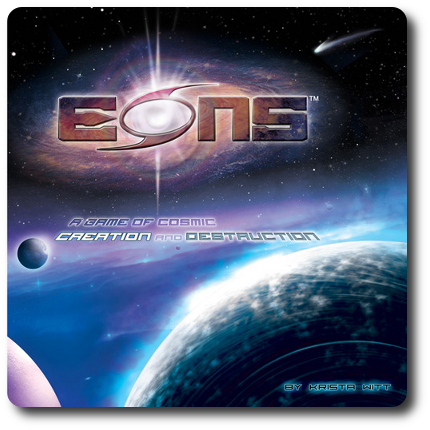
The Basics:
- For ages 9 and up (publisher suggests 14+)
- For 2 to 5 players
- Approximately 90 minutes to complete
Geek Skills:
- Counting & Math
- Logical & Critical Decision Making
- Pattern/Color Matching
- Strategy & Tactics
- Hand/Resource Management
Learning Curve:
- Child – Easy
- Adult – Easy
Theme & Narrative:
- Become a Cosmic Architect and build or destroy the universe as you see fit…
Endorsements:
- Gamer Geek approved!
- Parent Geek approved!
- Child Geek approved!
Overview
Carl Sagan said “The universe seems neither benign nor hostile, merely indifferent.” Stars are born and die. Galaxies expand and collapse. It’s a dance of creation and destruction that is played out eon after eon on a cosmic level. But there is order to the chaos. For each cause there is an effect and after every death there is new life. Sadly, nothing lasts forever…
EONS, designed by David Villegas, Christopher Witt, Krista Witt, and published by Gamer Nation Studios, is comprised of 1 game board, 90 Resource cubes (25 “Hydrogen”, 25 “Carbon”, 18 “Oxygen”, 12 “Iron”, and 10 “Uranium”), 5 Reference cards, 145 Cosmos cards, 5 Player tokens, 5 Focus tokens, 96 Essence tokens (60 “1 value” and 36 “5 value”), 1 Eon Cycle token, and 1 Entropy token. The game components are excellent and the artwork by Christopher West is outstanding, further reinforcing the game’s theme and narrative.
The Big Bang
To set up the game, first place the game board in the middle of the playing area. At least 1 player needs to have easy access to the game board, as the bits on it will be shifting every round of play.
Second, shuffle the Cosmos cards and deal to each player 7 cards, face-down. Players should look at their cards, but keep them hidden from their opponents at all times until played. The remaining cards should be placed to one side of the game board, face-down. This is the draw deck for the duration of the game. Leave room next to the draw deck for a discard pile.
Third, organize the Resource cubes into different colors on the designated space on the game board and place the Essence tokens off to one side of the game board. These are referred to as the stockpile. The number of Resource cubes to be placed is dependent on the number of players. Resources in EONS are not unlimited and their use might or might not return them to the game board. Refer to the game rule book for the correct number of Resource cubes to be placed. Any Resource cubes not used are returned to the game box.
Fourth, from the stockpile, give each player 4 “Hydrogen” Resource cubes, 3 “Carbon” Resource cubes, 2 “Oxygen” Resource cubes, 1 “Iron” Resource cube, and 10 Essence tokens. These should be placed in front of their owning player and are referred to as the player’s resource pool.
Fifth, collect the Player tokens and assign 1 to each player. Place these tokens on the zero position on the Victory Point tracker found on the edge of the game board. Any unused Player tokens are returned to the game box.
Sixth, place the Entropy token on the corresponding space indicated by the number of players. The game’s length can be shortened or lengthened by the players at this time by adjusting the Entropy token placement.
Seventh, place the Eon Cycle token on the “Create” space on the Eon Cycle track found on the game board.
This completes game set up. Determine who the first player will be for the first round and begin.
Creation, Entropy, and the Cosmos
Each player is taking on the role of a Cosmic Architect. Not gods, per se, but more like a force that drives change. Feel free to think of yourself as a god or goddess if it helps, however. My 9-year-old did. He named himself “Omega Galactica”.
As Cosmic Architects, each player will be building part of the universe. This includes planets and stars., but building a universe is not that simple. Every planet or star that blinks into existence must be comprised of the basic building blocks that are a part of all aspects of creation. Specifically, “Hydrogen”, “Carbon”, “Oxygen”, “Iron”, and “Uranium”. And, yes, before you go all “scientific” on the game, understand that the game designers attempted to simplify a process that none of us understand fully. The elements in the game only represent a small number of what we “think” is the complete Periodic Table.
Essence is the currency of willpower that you, as a Cosmic Architect, exert upon creation itself. As stars and planets are born, elements are used, spent, and sometimes lost, but the universe is also alive and stars will contain elements that Cosmic Architects can use to build more planets and stars. You can always obtain more Essence, but the elements are limited. Sometimes they’re recycled and sometimes they’re lost forever.
The universe is not a safe place. Players can “attack” their opponents’ heavily bodies, destroying planets and stars. Stars can also die a “natural death” and leave once warm corners of the universe cold and lifeless. As the universe ages and destruction occurs, it begins to suffer entropy. A Cosmic Architect’s first order of business is creation and order, but death and chaos is inevitable, as well as a natural end to existence itself.
The Cosmic Clock
EONS is played in rounds and turns with each player taking actions during specific phases. A typical round is summarized here. Note that the first round’s turn order sequence is based on the randomly or specifically selected “first player”. After that, the turn order sequence is determined by player victory points by going either “high to low” or “low to high”. The Eon Cycle token is moved from one phase to another to help keep track of what actions are available for the round.
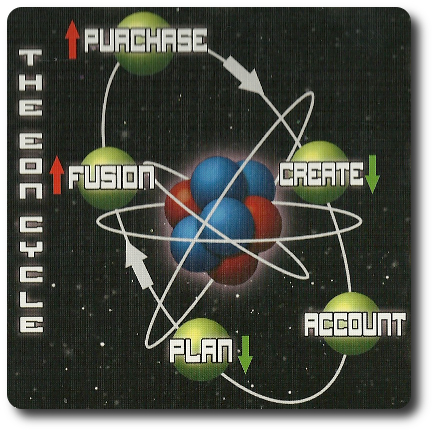
Phase 1: Create
Starting with the player who has the most victor points, each player selects 1 Cosmos card from their hand and places it, face-up, in front of them. Once placed, the player MUST pay the resources noted on the Cosmos card. Resources must come from the players resource pool. Where the resources are sent is based on the card. Some cards will state the resources are placed on the card itself, some back in the stockpile, and sometimes the spent resources are removed from the game!
The resources the player will spend include “Hydrogen”, “Carbon”, “Oxygen”, “Iron”, “Uranium”, and Essence (which is the equivalent to “money” in the game). If a player cannot pay the cost of the card, they cannot play the card. A player will then have to “pass” or they can elect to “pass” at anytime during this phase. Doing so, however, means they can no longer participate in this phase of the game.
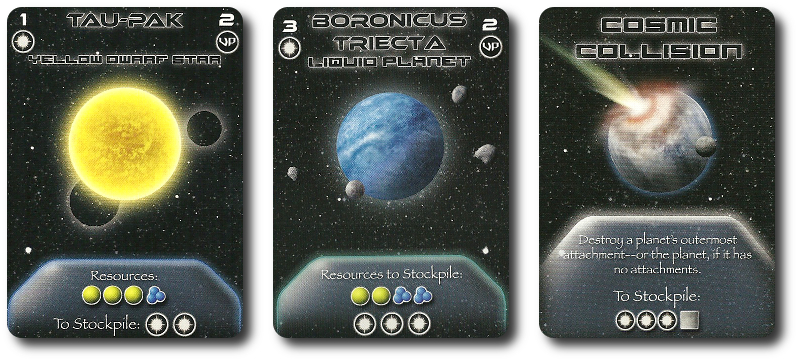
A star, one of its two planets, and the asteroid the size of Texas that’s about to destroy it…
Note that a player can also, at anytime during this phase even if they have passed, move their Focus token once to any Cosmos card they have played. Focus tokens protect the card from other players and their attacks. Put another way, if a player has a Focus token on a card, that card is shielded for the round.
Once all the player’s pass, the phase ends and the next phase begins.
Phase 2: Account
Each player now collects the Essence generated by their played Cosmos cards. Essence should be taken from the stockpile by the game board. Players also adjust their victory points at this time, counting up the total number and then adjusting their token on the game board track accordingly. The number of victory points is not added or subtracted from the last round’s victory point value. In other words, it’s not accumulative. Whatever the new total is determines the player’s position on the track.
Note that planets DO NOT provide Essence or victory points unless they’re orbiting a star! Players can complete this phase in turn order sequence or out of turn. I suggest you do it in turn order sequence to keep things organized.
Phase 3: Plan
Starting with the player who has the most victory points, each player can now discard any number of cards remaining in their hand. Discarded cards are placed, face-up, in the discard pile. Then each player takes as many cards as necessary from the draw pile to fill their hand back up to 7 Cosmos cards.
Phase 4: Fusion
Starting with the player who has the lowest victory points, each player determines which elements are created by their stars. This processes of creating elements is called “fusion” (the process or result of joining two or more things together to form a single entity). Each star Cosmos card keeps its original elements when it’s created. Using these elements, a player transmutes the elements on the star to new elements using the Fusion Cycle chart found on the game board. Players are welcome to complete 1 or more fusions, as long as they can take the elements from the star Cosmos card and complete the fusions at the same time. Elements are taken from the star card, exchanged with other elements from the stockpile, and then returned to the star Cosmos card.
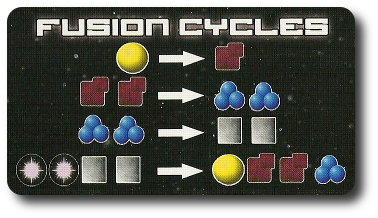
After a player has completed all the Fusion Cycles with their stars, they can take any number of the NEW elements and Essence from the star Cosmos cards and add them to their own pools. Any not claimed remain on the star and can be used during the next Fusion phase.
All stars must undergo at least 1 fusion or die. Players must complete a Fusion Cycle if possible. If a star dies, all elements on the star Cosmos card are returned to the stockpile and the star Cosmos card is discarded. The player then takes 1 “Uranium” from the stockpile (if possible) and adds it to their pool. Finally, the Entropy token is moved to the next LOWEST value.
Phase 5: Purchase
The final phase allows each player, in turn order sequence, to spend their Essence to purchase new resources from the stockpile. Spending Essence for elements is not cost-effective, but it does allow players to obtain much-needed elements for the next round of play. Spent Essence is placed back in the Essence stockpile, but the only elements available for purchase are those on the game board in their designated spaces.
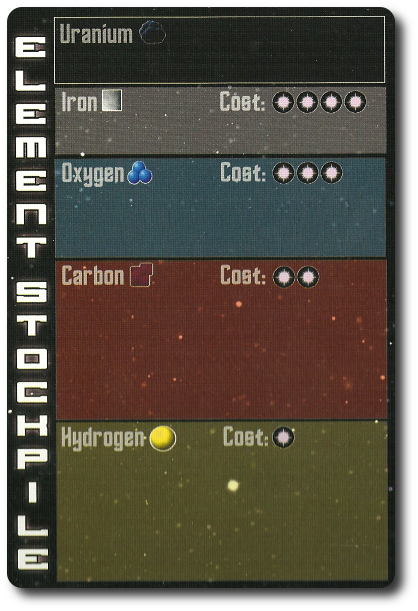
This completes the game round. The Eon Cycle token is returned to the first phase and the game continues.
Universal Winner
The game continues as described above until the Entropy token is moved to the zero position. The universe has now reached a point where it’s spread too thin, but the game continues until the next Account phase. The final Account phase is completed as described above. The player with the most victory points wins the game! Ties are broken by counting Essence tokens.
Game Variants
EONS can be played using scenarios that change the game’s starting state and the winning conditions. Players are even able to play the game alone, if they like. Two scenarios are provided in the game box and more can be found on the game’s web page.
EONS can also be played as cooperative game. This is a great way to play the game with younger players and with those who do not care for aggressive game play. The game set up is different and scenarios can be used if the players like. Like most cooperative games, players will either all win or all lose.
To learn more about EONS, visit the game’s web page.
Prediction
EONS is, at its core, a Territory Building game with an emphasis on hand and resource management. Neither of which are unfamiliar to all 3 of our playing groups. I predict that all 3 groups will find something they enjoy about the game, but I am not convinced that all 3 will fully enjoy it. The “take that” element in the game play has me questioning the game as a whole. The game is all about creating a universe and then slowly winding it down into entropy. That’s pretty interesting right from the start, but when you introduce random and deliberate events provided by opponents that are meant to harm and delay, it takes a big chunk out of the order the players are attempting to establish. I think there will be an equal number of players in all 3 groups who both enjoy and dislike this type of game play. As such, a “mixed” result is what I am expecting at the very least.
Teaching EONS is very simple. In fact, the most complicated aspect of the game is the timing, but this is nothing you can teach. Building the universe is very straight forward. Pay elements to play Cosmos cards. Destroying a universe takes some thinking. Each player will be given the opportunity multiple times to add a massive amount of chaos to the normally well-ordered universal system. Knowing when to introduce chaos is just as important to knowing how to build order. Lucky for new players, nothing about or in the game is what I would consider “difficult”, but it’s not enough for players to build a well-oiled universal machine. They must also actively throw in the proverbial “monkey wrench” into their opponent’s galaxy to remain competitive. Note that the game does require its players to be able to read the text on the Cosmic cards. If playing with Child Geeks who cannot read well, I suggest you use the cooperative rules.
And so, after teaching EONS to my oldest little geek, I asked him his thoughts on the game so far.
“I really like this! It all makes sense and I LOVE how I get to create new galaxies!” ~ Liam (age 9)
There is something very neat about creating new galaxies. Nothing in great detail, mind you, but it’s strangely thrilling to create stars and orbiting planets or the occasional galaxy destroying black hole. Let’s play EONS and see if it’s worth our time and universally enjoyed.
Final Word
The Child Geeks were evenly mixed when it came to EONS. As predicted, the “take that” element of game play soiled an otherwise enjoyable gaming experience for some of the Child Geeks. Understand that Child Geeks are still developing their emotional coping skills, and as such, have a hard time dealing with conflict in games. This is especially true when they go through the effort to create a star with orbiting planets only to see it destroyed with no way to protect that which they have worked hard to bring about. Luckily for the game, all the Child Geeks who felt pretty negative towards EONS were well below the recommended game’s age level, so they were not counted. When we introduced the cooperative game play, everything changed. Indeed, EONS felt like a different game and all the Child Geeks, both young and old, had a wonderful time. According to one Child Geek, “I like playing against my parents, but playing with them was a lot more fun.” When the games were over, the Child Geeks were mixed when it came to the basic game play, but thoroughly enjoyed EONS as a cooperative game with the family.
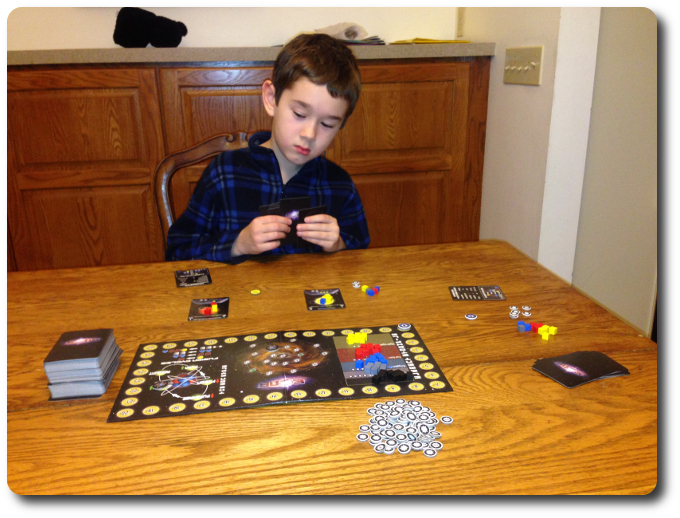
My little Cosmic Architect, “Omega Galactica”, quietly observes the universe before his turn
The Parent Geeks enjoyed both the basic and cooperative game, and felt so-so about the scenarios. According to one Parent Geek, “What I like about this game is its ability to be played differently depending on what type of game you want. If I’m with my family, I like to play it cooperatively. If I’m with my husband’s friends, I want to kick their butt.” Ha! Not unexpected was how much the Parent Geeks enjoyed the educational aspect of the game. Their Child Geeks were asking questions about cosmic bodies and the universe, which lead to trips to the library and watching interesting videos on YouTube. One Parent Geek said, “Any game that educates and entertains is a game well worth putting in front of my kids and on my gaming table.” All the Parent Geeks voted to approve EONS.
The Gamer Geeks beat this game up. Gaming elitists take it upon themselves to stress test any game I put in front of them in hopes of proving to no one in particular how awesome they are. During their attempt to “break the game”, the Gamer Geeks observed and reported several different findings. First, they all found EONS to be a very tight and well structured resource management game. Second, the Gamer Geeks felt that the player “take that” aspect of the game felt out-of-place at times, but was enjoyed. Third, there are some very interesting strategies to pursue and tactics to use during game play. Fourth, the non-cumulative scoring was a bother. Specifically, it didn’t matter how well a player did during the game. Only the last round mattered. Of course, this created interesting arguments about the importance of certain strategies, but the end result was that all the Gamer Geeks enjoyed the game well enough to give it their vote of approval.
I really like this game. There is just something about creating a universe that appeals to me. I bet it’s an ego thing. I also really like how I can generate my own resources by playing stars, but the universe I am creating starts to slowly die. The player combat is light, but can be very destructive and bothersome. It can also be very wasteful and costly. Some players didn’t care for it, but I found it to be a smart way to introduce “intelligent chaos” in a game that was all about creating order. It also made you, as a Cosmic Architect, take certain precautions and play according to your opponents’ personalities. For example, I would focus fully on developing my galaxies when I was playing with my kids, occasionally blowing up a star or two when playing with the Parent Geeks, and introduce as many black holes as possible when competing with the Gamer Geeks. Each game was different, as was the point spread. Our biggest galaxies were built when everyone played peacefully and there were barely any planets or stars to speak of when the games were aggressive.
EONS is very tight, plays well, feels balanced, and only leaves me feeling disappointed when I don’t win. Do play a game or two of EONS if the opportunity should present itself. It’s unique enough to warrant interest and fun enough to keep playing. An intriguing resource management game of cosmic proportions that fits nicely on your gaming table.
This game was given to Father Geek as a review copy. Father Geek was not paid, bribed, wined, dined, or threatened in vain hopes of influencing this review. Such is the statuesque and legendary integrity of Father Geek.




Pingback: Today in Board Games Issue #125 - Today in Board Games
Would the game still be playable if ‘attack’ cards could only be played on yourself?
Yes, but that’s not how the game was meant to be played to the best of my understanding. The “attack” cards are so named because they allow a player to mess with an opponent’s plans. The result of the card is destruction of other cards or general tampering of strategic and tactical play. A player could play the cards on themselves and should if the results would be beneficial (dead planets and worthless stars can be recycled for something worthwhile), but the idea of only playing the cards on the player who owns them would reduce the game’s fun, I think.
Good question, Thomas!